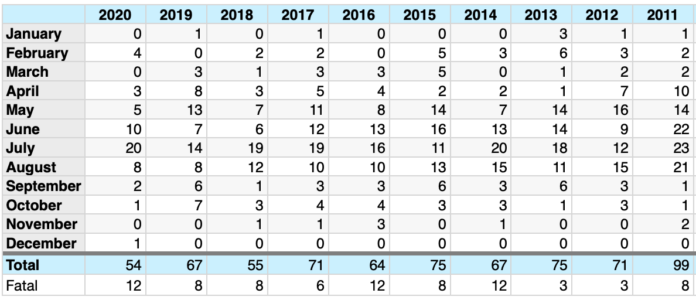by Bill Lavender
During the first months of each year, AgAir Update publishes the previous year’s accidents and fatality statistics. Providing this information earlier is not possible due to the delay of receiving data from the NTSB, even later this year assuming the government’s COVID 19 concerns. Some accident reports are preliminary and the details may change from the original report. There are still nine incomplete reports from NTSB for Part 137 aircraft.
AgAir Update takes all data related to agricultural aircraft operations as described by the NTSB, regardless whether the operation was actually operating under Part 137 at the time of the incident. This includes ag-aircraft operating Part 91 (ferry/reposition), mosquito control, cherry drying, etc. What this means for the reader is data from AgAir Update may not match data from NAAA or other sources that use different methods of calculation.
AgAir Update categorizes accidents and fatalities with easy to read graphs. Comparisons between type aircraft and geographical locations does not take into account the unknown number of hours flown or the number and type ag-aircraft registered in each state. Therefore, assumptions should not be made that any particular aircraft or state’s statistics are any worse or better than another.
TOTAL ACCIDENTS BY YEAR
In 2020, there were 54 accidents, including one midair, and 12 fatal accidents with 13 deaths when including the midair that was reported by the NTSB compared to 67 accidents with 8 fatalities in 2019; less accidents but a higher number of fatalities. This accident number of 54 is the lowest in ten years with 99 the highest in 2011. However, 2020 exceeded any other previous year in 10 with 13 pilot fatalities with a total of 81 pilots killed in the last 10 years; an astounding number. Year 2013 with the best of all ten years with an accident-to-fatality ratio of 4%, while 2020 was the worst year at 22.22%.
 TOTAL ACCIDENTS IN 2020 BY STATE
TOTAL ACCIDENTS IN 2020 BY STATE
This year Arkansas had the most accidents with 7. There was an appreciable number of states with only one accident, 11 of 24 states reporting accidents. Only one accident separated these states from a perfect no-accident year. Several states are not listed because there were no accidents reported. Oddly enough, there were two accidents in Alaska. These can be contributed to aerial firefighting missions.
ACCIDENTS BY MONTH
In 2020, the most accident prone month of the year, was July with 20 accidents. Summer is when most ag hours are flown. The months of July with 20 and June with 10 are months in 2020 with double digit numbers. Thirty of the 54 accidents in 2020 (55.5%) occurred in June and July. Compared to 2019, 27 of 67 accidents (40.2%) occurred in May and July.
 ACCIDENTS BY AIRCRAFT
ACCIDENTS BY AIRCRAFT
Air Tractor came in first with the most accidents at 24 in 2020, followed by helicopters with nine. Obviously, the Air Tractor is the most numerous ag-aircraft in the ag-aviation fleet and would be expected to have the most accidents. According to NAAA’s 2019 Aerial Application Industry Survey (published in the winter 2020 edition of Agricultural Aviation magazine), the helicopter industry makes up 13% of the ag-aircraft fleet and were involved in 16% of accidents in 2020. Ag-Cat and Thrush nearly tied with eight and seven accidents respectfully. Examining the graph, “Accidents by Aircraft”, the accident rate seems to follow the number of aircraft in the fleet percentage-wise with the exception of the Ag-Cat. Why that is anyone’s guess. Maybe it is related to the Ag-Cat being a good aircraft to start out a green ag-pilot.
 FATALITIES
FATALITIES
There were 12 fatal accidents in 2020. Six fatal accidents with seven fatalities in Air Tractors, two in Cessnas and helicopters and one each in an Ag-Cat and Pawnee. There may be speculation as to the survivability of any type of ag-aircraft. However, there are too many other underlying factors that cause an accident, or a fatality, to make assumptions.
 MECHANICAL, NON-MECHANICAL AND UNKNOWN CAUSES
MECHANICAL, NON-MECHANICAL AND UNKNOWN CAUSES
AgAir Update reads each report to determine whether an accident is mechanical, non-mechanical, or unknown. There were 10 unknown causes of accidents in 2020. AgAir Update is assuming this is mostly due to the final figures not yet updated. These should later be resolved and categorized as to whether mechanical or non-mechanical. In any case, the non-mechanical, which can be summarized as being caused by the pilot or weather (which is indirectly a pilot causation), outweigh the number of mechanical accidents, 34 versus 10 (3.4:1).
No one person or thing can effectively change accident statistics in ag-aviation more so than the pilot. Of course, the operator can provide safer equipment in a safer working environment. PAASS can educate and create safety awareness. Even the government can regulate safety, to a degree. However, the ultimate responsibility of safety belongs to the pilot.
There are plenty of tools available to improve the chances of an accident-free season. One of the best is participation in NAAA’s PAASS program. With its nationwide availability during most ag-pilots’ off-season, even during COVID, there is no excuse for not participating. An old timer operator once said, “Don’t bend my airplane.” Anyone who knew that operator understood his real intent was the pilot would not hurt himself if he didn’t bend the aircraft.





